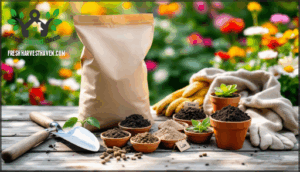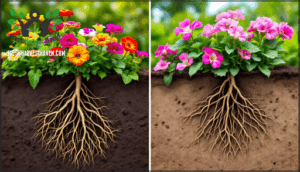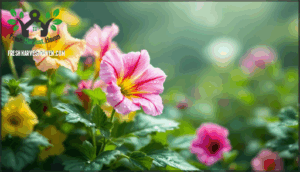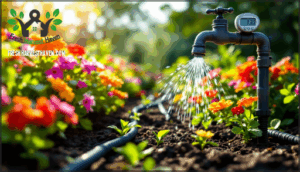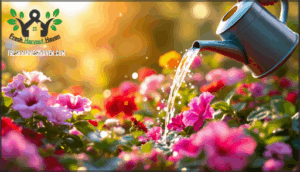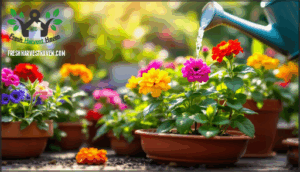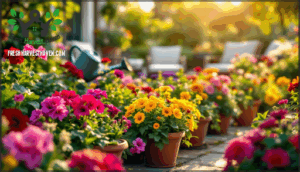This site is supported by our readers. We may earn a commission, at no cost to you, if you purchase through links.
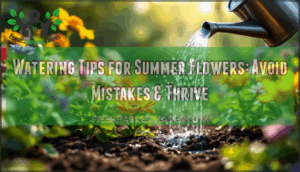
The difference between lackluster flowers and show-stopping displays often comes down to mastering a few fundamental watering techniques. When you understand how water moves through soil, when roots actually need it, and which methods keep foliage dry while roots stay hydrated, you’ll realize your plants’ full potential.
These practical watering tips for summer flowers will help you avoid the most common mistakes and create conditions where your garden doesn’t just survive the heat—it flourishes through it.
Table Of Contents
Key Takeaways
- Deep watering once or twice weekly builds root systems reaching 12+ inches deep, making plants 26% more drought-resilient and reducing root rot by 24% compared to frequent shallow watering that keeps roots in the top 2-4 inches.
- Morning watering allows foliage to dry quickly in sunlight, cutting fungal disease risk by over 40%, while keeping water off leaves entirely prevents pathogens like powdery mildew and black spot from taking hold.
- Proper drainage through quality potting mix, adequate container holes, and soil amended with organic matter prevents root suffocation and allows oxygen to reach roots, with each 1% increase in organic matter retaining 20,000 extra gallons per acre.
- Your soil type dictates watering frequency more than any schedule—sandy soil drains within an hour and needs daily watering during heat, while clay retains moisture longer but risks suffocation, making the finger test 2-3 inches deep your most reliable moisture gauge.
Common Watering Mistakes to Avoid
Watering summer flowers seems straightforward, but many gardeners unknowingly make mistakes that stress or kill their plants. Overwatering suffocates roots, while underwatering leaves them parched and struggling.
Let’s look at the most common errors and how to prevent them.
Dangers of Overwatering and Root Rot
When you overwater, you’re basically drowning your plants. Root rot causes occur because waterlogged soil blocks oxygen from reaching roots, triggering fungal diseases and oxygen deprivation. Here’s what happens:
- Roots suffocate and decay in saturated soil
- Fungal pathogens multiply rapidly in wet conditions
- Leaf yellowing appears as roots fail to absorb nutrients
- Plant survival becomes threatened as the root system collapses
This silent killer affects watering techniques across all container and garden plantings. One major issue is waterlogged soil, which prevents proper drainage and aeration.
Signs of Underwatering and Plant Stress
While overwatering drowns roots, underwatering starves them. Wilting leaves and dry soil signal trouble—plants lose turgor, causing stems to droop and leaves to curl like potato chips. Yellowing leaves and stunted growth follow as water absorption drops, impairing chlorophyll production.
Under drought conditions, you’ll notice necrosis signs: brown, crispy leaf edges where cells have collapsed. Flower impact shows up quickly too—buds drop prematurely, and blooms shrink or disappear entirely, reducing your summer display.
You can often observe curling leaf edges when plants are underwatered.
Importance of Proper Drainage
Good drainage isn’t just a nice-to-have feature—it’s the difference between roots that breathe and roots that suffocate. Without proper drainage holes in containers or good soil drainage in raised garden beds, water pools around roots, blocking oxygen.
Amending heavy clay with compost improves soil compaction issues, while drainage fabric prevents waterlogging—essential watering tips for summer success.
Preventing Fungal and Bacterial Pathogens
When poor drainage combines with overhead watering, fungal diseases thrive. Wet foliage overnight invites pathogens like powdery mildew and black spot. Morning watering allows leaves to dry quickly, cutting fungal growth risk by over 40%.
Air circulation through proper spacing reduces infection rates by 42%, while sunlight exposure naturally inactivates up to 90% of pathogens.
Good hygiene practices matter too: disinfect pruning tools and avoid touching damp plants. You can also introduce biological controls like Trichoderma during transplanting, and maintain soil pH between 5.5 and 7.5 to suppress bacterial survival, preventing plant diseases before they start.
Choosing The Right Soil and Tools
The foundation of healthy summer flowers starts before you even turn on the hose. Your soil quality and watering tools work together to deliver moisture efficiently while preventing common problems like waterlogged roots or uneven coverage.
Let’s look at the key materials and equipment that’ll set your flowers up for success.
Benefits of Quality Potting Mixes (e.g., Miracle-Gro)
Quality potting mix acts like a well-engineered sponge, holding moisture where roots need it while letting excess water drain away before trouble starts. Look for products designed for container gardening, as they balance water management with nutrient retention.
Here’s what quality mixes deliver:
- Enhanced drainage improvement prevents waterlogged roots
- Better root development through well-balanced air pockets
- Increased disease resistance by discouraging fungal growth
- Improved nutrient retention for consistent feeding
- Soil drainage that’s well-suited to your watering schedule
That’s why investing in proven potting mix pays off in plant health.
Selecting Watering Wands and Soaker Hoses
With your potting mix sorted, the next step is choosing tools that deliver water where it matters most—directly to the root zone without wasting a drop. A quality watering wand with adjustable wand length and multiple wand spray patterns lets you control flow precisely.
Soaker hoses offer steady, slow moisture delivery when you set up proper soaker hose placement along your beds. Look for hose material durability and timer compatibility to automate your watering techniques and keep your flowers thriving all summer.
Ensuring Proper Container Drainage
Even the best soil and tools won’t save your flowers if water pools around their roots, turning your containers into swamps where oxygen can’t reach and root rot takes hold. Check every container for drainage holes at least half an inch wide—smaller openings clog fast.
Clear blocked holes regularly to keep drainage maintenance tips working all season. Layer broken pottery or gravel at the bottom if your potting mix choice leans heavy. Plastic containers retain moisture longer than terracotta, so adjust your watering accordingly.
Tools to Monitor Soil Moisture
Guessing when your soil’s dry enough—or too wet—turns watering into a gamble, but a few simple tools eliminate the mystery and give you reliable reads every time. A soil moisture gauge drives into your container to show exact wetness levels. Smart watering systems pair with soil monitoring apps for automated alerts. For low-tech checking moisture levels, your finger meter—yes, your actual finger pushed two inches down—works surprisingly well.
Tools that take the guesswork out of watering:
- Moisture meter types range from analog probes to digital displays that show readings in seconds
- DIY moisture sensors using basic electronics give tech-savvy gardeners real-time data at minimal cost
- Visual soil assessment teaches you to read color shifts and texture changes like a pro
- Watering wand with built-in flow control lets you deliver precise amounts exactly where roots need them
- Smart watering systems connect to weather forecasts and adjust schedules automatically during heatwaves
Best Watering Techniques for Summer Flowers
How you water makes all the difference in keeping your summer flowers healthy and blooming. The right technique goes beyond just turning on the hose—it’s about delivering water in a way that strengthens roots and prevents disease.
Let’s look at the most effective methods to water your summer garden.
Deep Watering Vs. Frequent Shallow Watering
Deep watering encourages your flowers’ roots to reach 12 inches or more into the soil, compared to just 3–4 inches with shallow watering. This makes plants more drought-resilient and disease-resistant. You’ll use 20–25% less water overall and reduce fungal issues by up to 40%.
Here’s how the two watering techniques compare:
| Factor | Deep Watering | Shallow Watering |
|---|---|---|
| Root Depth | 12+ inches | 2–4 inches |
| Watering Frequency | 1–2 times per week | 4–5 times per week |
| Disease Resistance | 24% lower root rot | 35% more fungal infections |
| Water Efficiency | 50% better absorption | 40% evaporates quickly |
| Drought Resilience | 26% higher survival | 45% more irrigation needed |
Deep watering creates stronger, healthier flowers that withstand summer heat better. You’re building root systems that tap into soil moisture reserves, not just surface dampness.
Avoiding Wetting The Foliage
Wet leaves are like an open invitation to powdery mildew, black spot, and a host of fungal diseases that can devastate your summer flowers in just days.
Wet leaves invite powdery mildew, black spot, and fungal diseases that devastate summer flowers in days
When water sits on foliage, it creates ideal conditions for leaf spot and other plant diseases to develop.
Using Drip Systems and Timers
Installing a drip system or soaker hose on a timer takes the guesswork out of watering and keeps moisture right where your plants need it—at the roots—without ever touching the leaves. You can customize your watering schedule based on your plants’ specific needs, adjusting frequency and duration as summer heat intensifies.
These systems conserve water by delivering it slowly and directly to the root zone, reducing evaporation and runoff. Installation challenges like uneven water pressure or clogged emitters are minimal if you flush the lines regularly and check for kinks.
Watering at The Optimal Time of Day
Morning is hands-down the best time to water, because wet foliage dries quickly in the morning sun and plants absorb moisture before the day’s heat hits. Early evening works too, but watering at night invites fungal diseases since leaves stay damp longer.
Avoid watering midday when evaporation rates spike and sun exposure can stress plants—early morning minimizes disease while maximizing water uptake.
Setting The Right Watering Schedule
Getting the timing right makes all the difference between flowers that barely survive and ones that truly flourish. Your watering schedule isn’t a one-size-fits-all approach—it shifts based on your plants’ age, the weather, and what’s happening beneath the surface.
Let’s break down how to create a schedule that works for your garden’s unique needs.
Daily Watering for New Plantings
When you tuck a new plant into the ground, its roots haven’t yet anchored themselves deep enough to seek out moisture on their own, so daily watering becomes their lifeline during those critical first few weeks. This consistent hydration balance helps counteract transplant shock while encouraging root establishment.
Check soil saturation by feeling an inch below the surface—if it’s dry, your seedlings need water. Deep watering techniques make certain moisture reaches developing roots rather than just wetting the surface.
Adjusting Frequency by Plant Type and Weather
Once new plants settle in, your watering schedule needs to flex with both plant water needs and weather impact. Seasonal watering adjustments become your secret weapon—flowering annuals might crave daily drinks during brutal heat, while established perennials thrive on every-two-to-three-day soaks. Here’s how to nail your watering frequency:
- Heat-loving cacti stretch to 2–3 weeks between watering, while moisture-loving basil demands attention 2–3 times weekly
- Container plants outdoors dry twice as fast as ground beds, sometimes needing morning and evening hydration
- Mediterranean herbs like lavender need half the water that tropical houseplants require during summer
Check soil moisture 2–3 inches down before watering—that finger test prevents guesswork and keeps roots healthy.
Soil Type and Its Impact on Watering Needs
Your soil type dictates summer watering needs more than you might think. Sandy soil drains fast—water slips through in under an hour—so flowers planted there need frequent drinks, sometimes daily during peak heat. Clay composition retains moisture longer but can suffocate roots if you’re not careful. Loam benefits from balanced drainage and water retention, storing nearly 2 inches per foot of depth.
Boost any soil with organic matter—each 1% increase lets your garden retain 20,000 extra gallons per acre, giving summer flowers the steady hydration they crave without constant intervention.
Recognizing When to Water Based on Soil Moisture
Your finger is your best moisture meter—push it two to three inches below the surface, and if the soil feels dry at that depth, it’s time to water. Digital moisture meters confirm what manual soil checks reveal, but visual plant cues like drooping leaves or dull foliage signal stress before wilting begins.
Checking soil moisture levels this way prevents guesswork and helps you adjust watering frequency impact based on real conditions, not arbitrary schedules.
Tips for Healthy and Thriving Summer Flowers
Once you’ve nailed your watering schedule, a few smart habits can take your summer garden from surviving to thriving. These practical strategies help your flowers withstand heat stress while keeping water use efficient.
Let’s look at the techniques that support vibrant blooms all season long.
Conserving Water in Hot Weather
Water conservation during summer’s heat isn’t just about saving resources—it’s about working smarter. Apply a two-to-three-inch layer of mulch around your flowers to reduce evaporation and keep roots cool. Choose drought-tolerant varieties that tolerate heat stress better.
Collect rainwater in barrels for later use, or consider greywater from your household. These watering tips minimize water waste while protecting your plants from drought conditions during intense heat.
Flushing Soil With Rainwater or Distilled Water
Over time, mineral salts from tap water and fertilizers build up in soil like invisible chains around your plant’s roots—but flushing with rainwater or distilled water breaks them free. These watering tips restore soil health and prevent summer flowers from suffering nutrient lockout caused by mineral buildup.
Flush your containers monthly with:
- Rainwater collected from storms—it’s naturally soft and free of chlorine
- Distilled water poured slowly until it drains completely through the pot
- Three times the pot volume to thoroughly rinse accumulated salts away
This simple practice prevents common watering mistakes that stress plants during peak growing season.
Preventing Water Stress During Heatwaves
When temperatures soar past 90°F, your summer flowers lose water through their leaves faster than a leaky bucket—and without intervention, wilting sets in within hours. Mulching strategies reduce evaporation by insulating soil, while shade cloth blocks intense afternoon sun.
Water plants early morning to build drought tolerance before heat peaks. Monitor wilting closely—it signals immediate water stress requiring deep watering to prevent cellular damage and promote heat acclimation.
Supporting Plant Health and Growth With Proper Hydration
Consistent hydration doesn’t just keep flowers alive—it unlocks their full genetic potential for sturdy stems, vibrant blooms, and resilient immune systems against pests and disease. Proper watering techniques support plant growth through:
- Root health – Deep watering encourages strong root systems that anchor plants securely.
- Nutrient absorption – Adequate moisture helps roots uptake essential minerals from soil.
- Photosynthesis support – Hydrated leaves efficiently convert sunlight into energy.
- Disease resistance – Well-watered plants maintain cellular integrity, resisting fungal and bacterial pathogens naturally.
Frequently Asked Questions (FAQs)
How much water do container flowers need daily?
Container plants can guzzle water like marathon runners on a scorching day. Flower type, container size, and environmental factors determine daily needs, but drainage effectiveness and soil composition matter most.
Check soil moisture regularly using proper watering techniques to avoid stress.
Can I use tap water for summer blooms?
Yes, you can use tap water for most summer blooms, though water quality matters. Hard water high in minerals may cause buildup over time, affecting soil pH. Chlorine usually evaporates quickly and rarely harms plants.
However, softened water contains excess sodium that damages roots, so avoid it entirely.
Should I fertilize while watering in summer heat?
Dilute fertilizer to half-strength during summer stress to prevent fertilizer burn. High temperatures reduce nutrient uptake, so lighter feeding protects root health.
Apply during cooler morning watering for safer plant growth without overwhelming stressed plants.
Do mulched flowers need less frequent watering?
Mulch acts like a protective blanket, shielding soil moisture from the sun’s relentless pull. Mulched flowers need less frequent watering because mulch reduces evaporation, retains soil moisture longer, and moderates temperature.
Mulch depth matters—apply two to four inches for best water retention and climate effects.
Whats the best water temperature for summer flowers?
Room-temperature water works best for summer flowers, avoiding cold water shock that stresses roots. Aim for water around 65-75°F, matching soil temperature.
Plants absorb warm water more efficiently, supporting healthy growth and consistent hydration during hot weather.
Conclusion
Picture your garden next summer—flowers standing tall through July heat, roots strong, foliage untouched by disease. That vision becomes reality when you apply these watering tips for summer flowers consistently.
Deep watering at dawn, monitoring soil moisture before acting, and keeping leaves dry aren’t complicated rituals—they’re simple habits that separate struggling gardens from impressive ones. Your plants won’t just endure the season; they’ll reward your attention with blooms that make neighbors stop and stare.
- https://extension.umaine.edu/about/staff-directory/ankit-singh/
- https://backyard.exmark.com/lawn-garden/signs-of-overwatering-or-underwatering-plants/
- https://ucanr.edu/blog/pests-urban-landscape/article/drought-or-disease
- https://pmc.ncbi.nlm.nih.gov/articles/PMC3877795/
- https://www.epicgardening.com/underwatering-plants/

